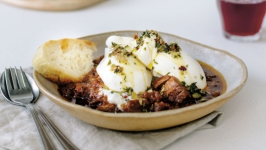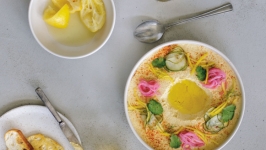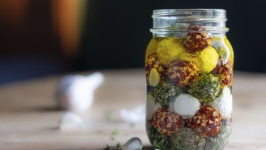Shutting Down Until Further Notice
When I packed my bags and moved away from my family in India, in 2013, to live in Providence, Rhode Island and Vancouver, it was always for the job. As a chef, I work an average of twelve hours a day, sometimes six days a week, often keeping my personal life at bay. The brutality of being a five-foot three-inch female chef on occasion tore me down. In time, I became tenacious and confident in speaking my mind without inhibition. Like my fellow chefs, I'm dedicated to the job, focused on the routine, standard of performance and pace of the kitchen, which made the sudden pandemic-forced vacation all the more shocking.
Life on the line
The job duties of a chef are unconventional and tedious. It drives us to our little work-is-life cocoon, while demanding that we persevere — shoulders straight — paying attention to every detail without fail. Our job description requires us to stand all day and to keep the kitchen swanky clean. We complete the mise en place list before we leave for the day and it's waiting for us as soon as we walk in the door the next morning. Some chefs will number the tasks in order of importance, while others don't even blink and blaze through the list. Days in the kitchen are never monotonous, but underneath it all, it’s the passion that drives us to a life on the line.
Space is tight even in the best of kitchens, forcing the motto of “clean as you go.” The saucier is diligently skimming sauces, the fish cook is breaking down filets and the entremetier is stirring purées in a pool of vegetables. It sounds straightforward, but technique and skill are required to execute. The "make it nice or make it twice" rule doesn’t leave us. Simultaneously, cooks are receiving orders, signing invoices, checking reservations, getting up to speed on the week’s events and mumbling about dietary restrictions. No one is fiddling around wondering what to do next because “if you have time to lean, you have time to clean.”
Our eyes are always on the big old kitchen clock, but the real game commences when we head to the line — where the cooking happens. The head chef reads out the orders as they're punched in. We're trained to echo back while our hands and legs move swiftly. Each station is like a department of a firm and the chefs in each know what they need to produce to the required standard of technique, taste and appearance. Teamwork and open communication are prerequisites. Like an assembly line, everyone passes their work along until the chef on the pass inspects and plates it. It seems simple enough, but imagine cooking ten orders and plating contrasting dishes while echoing the new ones to the cooks. It’s multi-tasking at it’s very best.
Restaurants are tuned in to turning tables. The ebb and flow of orders come in waves of highs and lows as guests have paid their cheque and new guests take over their seats. In the kitchen, we run our stations at full capacity on busy days, forcing us to drip sweat, catch a burn, but we never lose focus. If a teammate is losing the fight, another cook assists to finish the race. We save a little cheer or fist bumps until the last order leaves the pass. Then we wind down by scrubbing down — the stoves, ovens and the cubicle is packed away, knowing there lies another fruitful day ahead.
When the pandemic struck
When the pandemic struck, I was supposed to be treading the flurry lands of Whistler. Guilt-free, I had booked my itinerary — a stay at a pod-hotel, tubing down the mountain and soaking in Scandinavian outdoor baths — three months in advance hoping to have my sibling in tow.
The virus had set its plan into motion as the date of my reservation clashed with the pandemic headlines. It seeped into our everyday lives and forced us away from our routine. At work, the scenario quickly changed from, “wash your hands meticulously” to “we are shutting down till further notice.” Conversations no longer pertained to ideas for the spring tasting menu, but shifted to concerns about how to shut down a bustling kitchen operation. Fewer reservations for the previous two weeks worked in our favour. Nevertheless, it’s not an easy task when the kitchen is filled with the best of fresh produce, meats and seafood — stored like dollar bills stacked on top of one another in the walk-in fridge. Pickling, fermenting, and freezing replaced sous-vide, poaching and dry-ageing to become the hottest techniques of the pandemic season.
With no return date, there is only so much we could do. A basket of food made its way to my front door as if I were set to compete on Chopped with my black box of mysterious ingredients. I wish the circumstances would have been different and that the employment that put a roof over my head wasn't reduced to a miniature shopping basket. Weeks before the lockdown, the whole salmon I butchered and portioned would have sold for $42 a dish, but now it is vacuum-sealed in my fridge.
A chef in quarantine
The first two weeks felt like I was living in an alternate universe. A place where to-do lists were non-existent and deadlines didn’t matter. I was forced to give my knives and feet a rest and it felt like a big void swallowed the bustling restaurant and the hustle of working on the line.
With few choices, chefs and restaurateurs turned to delivery and take-out under stricter than the already stringent health-and-safety guidelines. As time progressed, businesses got creative with curbside pickups, grocery-store portals, e-gift cards, meal kits and do-it-yourself cocktail kits to make ends meet and donations to food banks rolled in. On the opposite end of the spectrum, professionals embarked on a new world of typing away from the comforts of home while home-schooling and navigating Zoom calls with furry photobombers. They used to come to us to satisfy their cravings, network, host clients and celebrate special occasions. But I can't work from home.
My twelve-hour workdays morphed into seemingly endless hours at home. I didn't have to play catch-up with my chores. I wallowed in the soothing scent of clean laundry as I leisurely washed my clothes in separate loads. Instead of feverishly prepping the day's mise en place, I cooked what my heart desired. Then followed the more intricate Marie-Kondo ways of re-organizing my pantry, filling the spice rack and arranging the cookbooks by genre. The question of what's next never stopped.
We let our creative minds wander and while at it, we waved our magic wands and utilized our home kitchens like never before. The cooking to impress guests switch was temporarily turned off and we were no longer obligated to share our work with anyone. For the fortunate few, we could still purchase the spring season’s top cookbooks, finish previously half-stewed ones, shake a cocktail and read while watching the sunset.
Some of my colleagues ran away to lockdown with loved ones given the uncertainty of seeing family again. Because we work around the clock — on Christmas and New Year’s Eve and Thanksgiving — the pandemic seems like a lucrative occasion.
Celebrity chefs are giving pep talks and cooking demonstrations on Instagram. Enthusiasts are whipping up Dalgona coffee and sourdough starters. And the over-achievers are bottling vinegar and fermenting kombucha.
Sincere chefs haven’t stopped the hustle and are continuing to test dishes. A few savoury cooks are dabbling in the messy world of baking — not helping the flour shortage. It’s a great time to reflect on our careers and focus on the question of what more can be done. The drive needs to stay, so we can get back in the saddle stronger, for our future and that of local food and dining. I, on the other hand, decided to write. Hopefully, some of the valuable habits we cultivate will carry forward. Until then, we're eagerly waiting to echo, “yes, Chef” concurrently. We'll be a little rusty, but there's no shame in that, of course.








